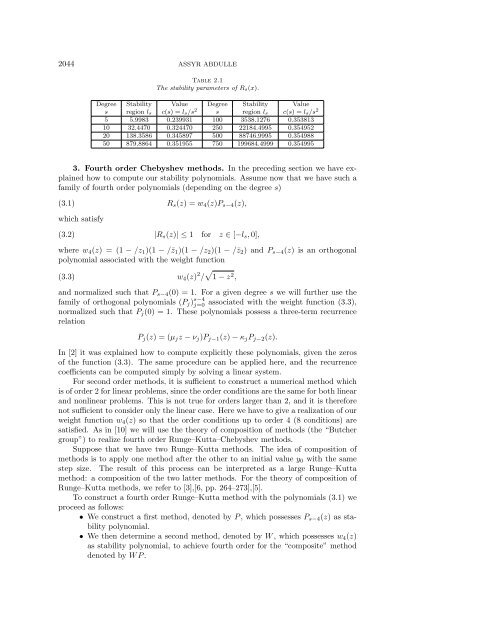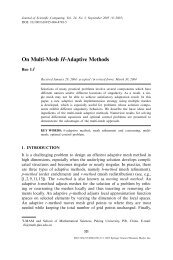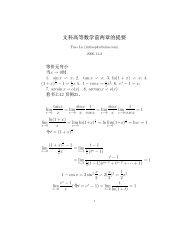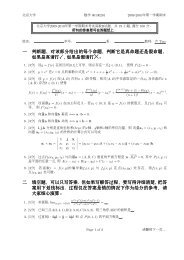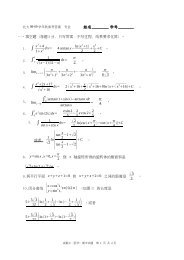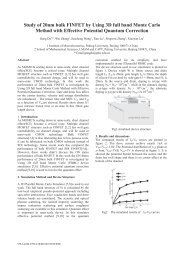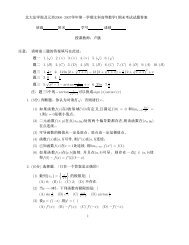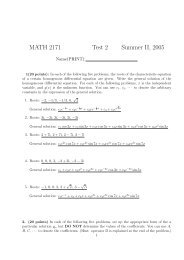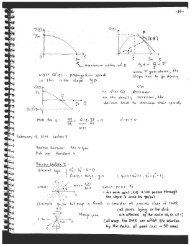fourth order chebyshev methods with recurrence relation
fourth order chebyshev methods with recurrence relation
fourth order chebyshev methods with recurrence relation
You also want an ePaper? Increase the reach of your titles
YUMPU automatically turns print PDFs into web optimized ePapers that Google loves.
2044 ASSYR ABDULLE<br />
Table 2.1<br />
The stability parameters of Rs(x).<br />
Degree Stability Value Degree Stability Value<br />
s region ls c(s) =ls/s 2 s region ls c(s) =ls/s 2<br />
5 5.9983 0.239931 100 3538.1276 0.353813<br />
10 32.4470 0.324470 250 22184.4995 0.354952<br />
20 138.3586 0.345897 500 88746.9995 0.354988<br />
50 879.8864 0.351955 750 199684.4999 0.354995<br />
3. Fourth <strong>order</strong> Chebyshev <strong>methods</strong>. In the preceding section we have explained<br />
how to compute our stability polynomials. Assume now that we have such a<br />
family of <strong>fourth</strong> <strong>order</strong> polynomials (depending on the degree s)<br />
(3.1)<br />
which satisfy<br />
(3.2)<br />
Rs(z) =w4(z)Ps−4(z),<br />
|Rs(z)| ≤1 for z ∈ [−ls, 0],<br />
where w4(z) =(1− /z1)(1 − /¯z1)(1 − /z2)(1 − /¯z2) and Ps−4(z) is an orthogonal<br />
polynomial associated <strong>with</strong> the weight function<br />
(3.3)<br />
w4(z) 2 / 1 − z 2 ,<br />
and normalized such that Ps−4(0) = 1. For a given degree s we will further use the<br />
family of orthogonal polynomials (Pj) s−4<br />
j=0 associated <strong>with</strong> the weight function (3.3),<br />
normalized such that Pj(0) = 1. These polynomials possess a three-term <strong>recurrence</strong><br />
<strong>relation</strong><br />
Pj(z) =(µjz − νj)Pj−1(z) − κjPj−2(z).<br />
In [2] it was explained how to compute explicitly these polynomials, given the zeros<br />
of the function (3.3). The same procedure can be applied here, and the <strong>recurrence</strong><br />
coefficients can be computed simply by solving a linear system.<br />
For second <strong>order</strong> <strong>methods</strong>, it is sufficient to construct a numerical method which<br />
is of <strong>order</strong> 2 for linear problems, since the <strong>order</strong> conditions are the same for both linear<br />
and nonlinear problems. This is not true for <strong>order</strong>s larger than 2, and it is therefore<br />
not sufficient to consider only the linear case. Here we have to give a realization of our<br />
weight function w4(z) so that the <strong>order</strong> conditions up to <strong>order</strong> 4 (8 conditions) are<br />
satisfied. As in [10] we will use the theory of composition of <strong>methods</strong> (the “Butcher<br />
group”) to realize <strong>fourth</strong> <strong>order</strong> Runge–Kutta–Chebyshev <strong>methods</strong>.<br />
Suppose that we have two Runge–Kutta <strong>methods</strong>. The idea of composition of<br />
<strong>methods</strong> is to apply one method after the other to an initial value y0 <strong>with</strong> the same<br />
step size. The result of this process can be interpreted as a large Runge–Kutta<br />
method: a composition of the two latter <strong>methods</strong>. For the theory of composition of<br />
Runge–Kutta <strong>methods</strong>, we refer to [3],[6, pp. 264–273],[5].<br />
To construct a <strong>fourth</strong> <strong>order</strong> Runge–Kutta method <strong>with</strong> the polynomials (3.1) we<br />
proceed as follows:<br />
• We construct a first method, denoted by P , which possesses Ps−4(z) as stability<br />
polynomial.<br />
• We then determine a second method, denoted by W , which possesses w4(z)<br />
as stability polynomial, to achieve <strong>fourth</strong> <strong>order</strong> for the “composite” method<br />
denoted by WP.


